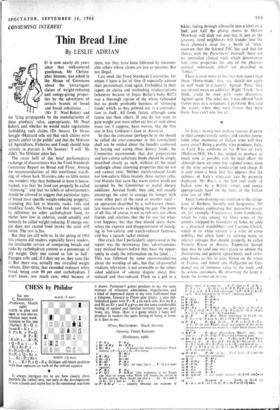Thin Bread Line
CONSUMING INTEREST
By LESLIE ADRIAN
The cases belli of this brief parliamentary exchange of discourtesies was the Food Standards Committee Report on Bread and Flour. Among the recommendations of this nutritional watch- dog, of whose bark Ministers take so little notice one wonders why they bothered to have it house- trained, was that 'no food can properly be called "slimming"' and that `no labels or advertisements should be allowed to suggest that particular types of bread have specific weight-reducing property,' extending this ban to biscuits, rusks, rolls and breakfast foods. No bread, said that report, and by inference no other carbohydrate food, no matter how low in calories, could sensibly and honestly be called weight-reducing. If energy out- put does not exceed food intake the eater will fatten. The rest is lies.
But they are still with us. In the spring of 1961 this column did readers, especially heavy readers, the invaluable service of comparing breads and rusks by carbohydrate content as a percentage of dry weight. Only one scored as low as half : Energen rolls and, if I dare say so, they taste like it. But there was actually one so-called weight reducer, Diet-thins, that exceeded ordinary white bread, being over 90 per cent carbohydrate. I don't know, nor much care, what became of them, but they have been followed by innumer- able others whose claims are just as specious. But not illegal.
Last week the Food Standards Committee, for whom I have a lot of time (I especially admire their persistence), tried again. Embedded in their report on claims and misleading misdescriptions (whatever became of Joyce Butler's baby Bill?) was a thorough reprise of the whole fatheaded but no doubt profitable business of 'slimming foods' which, as they pointed out, is a contradic- tion in itself. All foods fatten, although some fatten less than others. If you do not want to gain weight you must either eat less or rush about more (or, I suppose, have worms, like the film star in Eric Linklater's Juan in America).
So that the consumer (perhaps he or she should be called the over-consumer in this connection) shall not be misled about the benefits conferred by buying and eating these dietary foods, the Committee recommends that diet preparations and low-calorie substitute foods should be simply described clearly as such, without all the usual fandangle about slimming properties that do not and cannot exist. Neither starch-reduced foods nor low-calorie fillers (mainly those methyl cellu- lose biscuits that taste like warm cotton wool) are accepted by the Committee as useful dietary additions. Aerated foods, they add, will usually encourage the eater to assuage his hunger with some other part of the meal or another meal— an operation described by a well-known choco- late manufacturer as bridging the gap. The point of all this, of course, is not to rub into our obese friends and relations that the fat stay fat what- ever happens, but that they should spare them- selves the expense and disappointment of indulg- ing in low-calorie and starch-reduced fantasies, and buy a squash racket instead.
One crack that I particularly appreciated in the report was the throwaway line, `advertisements may mislead buyers before they have the oppor- ttmity to study the information on the label....' This was followed by some recommendations about the wording of ads., but that all-powerful medium, television, is not amenable to the sober- sided addition of solemn slogans about this- reduced and that-reduced. Flash on a girl in a bikini, fading through silhouette into a label on a loaf, and half the plump mums in Melton Mowbray will dash out and buy it, just as the scrawny, tired neighbours will wander into the local chemist's shop for a bottle ' of 'tonic' unaware that the learned FSC has said that (in chorus with the Prescribers Journal) 'there are no controlled clinical trials which demonstrate true tonic properties for any of the pharma- ceutical substances which are described as "tonics." ' There is even more to the four-bob report than these. 'Home-made,' they say, should not apply to stuff made in a factory. Agreed. 'Pure,' they say, should mean no additives. Right. 'Fresh,' they think, could be used with more discretion. Agreed again. The other day I was offered fresh frozen peas in a restaurant. I protested. But, said the waiter, when they were frozen they were fresh. You can't win 'em all.
As Italy's twenty-two million tourists disperse to their comparatively sunless and vineless home- lands what memories of Italian wine will they carry away? Being a prolific wine producer, Italy, as Cyril Ray confirms in his Wines of Italy (McGraw-Hill, 84s.), has tended to produce as much wine as possible with the least effort. So although there are some fine regional wines, most of the wine served is nondescript and cheap. It is only when a book like this appears that the richness of Italy's vineyards can be properly displayed. Mr Ray's is the first real study of Italian wine by a British writer, and comes appropriately hard on the heels of the Italian wine law of 1963.
Apart from drawing our attention to the attrac- tions of Barbera, Sassella and Sangiovese, Mr Ray produces captivating but instructive essays on, for example, Frecciarossa from Lombardy, which he rates among the finest wines of the country (shipped,by Giordano of Soho, he adds as a practical winebibber) and Lacrima Christi, which in its white version is a wine of some nobility, but often lends its striking name to inferior vintages that should, properly, be called Vesuvio Rosso or Rosato. Expensive though they may be (and one must pause to admire the illustrations and general appearance), such refer- ence books as this (it joins Simon on the wines of France, and Simon and Hallgarten on Ger- many) are of immense value to the trade and its serious customers. By informing the latter it keeps the former on its toes.


































 Previous page
Previous page